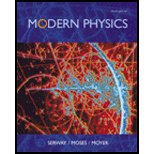
Modern Physics, 3rd Edition
3rd Edition
ISBN: 9780534493394
Author: Raymond A. Serway, Clement J. Moses, Curt A. Moyer
Publisher: Cengage Learning
expand_more
expand_more
format_list_bulleted
Textbook Question
Chapter 2, Problem 31P
A particle of mass m moving along the x-axis with a velocity component +u collides head-on and sticks to a particle of mass m/3 moving along the x-axis with the velocity component −u. What is the mass M of the resulting particle?
Expert Solution & Answer
Trending nowThis is a popular solution!

Students have asked these similar questions
Part C
Find the height yi
from which the rock was launched.
Express your answer in meters to three significant figures.
Learning Goal:
To practice Problem-Solving Strategy 4.1 for projectile motion problems.
A rock thrown with speed 12.0 m/s and launch angle 30.0 ∘ (above the horizontal) travels a horizontal distance of d = 19.0 m before hitting the ground. From what height was the rock thrown? Use the value g = 9.800 m/s2 for the free-fall acceleration.
PROBLEM-SOLVING STRATEGY 4.1 Projectile motion problems
MODEL: Is it reasonable to ignore air resistance? If so, use the projectile motion model.
VISUALIZE: Establish a coordinate system with the x-axis horizontal and the y-axis vertical. Define symbols and identify what the problem is trying to find. For a launch at angle θ, the initial velocity components are vix=v0cosθ and viy=v0sinθ.
SOLVE: The acceleration is known: ax=0 and ay=−g. Thus, the problem becomes one of…
Phys 25
Phys 22
Chapter 2 Solutions
Modern Physics, 3rd Edition
Ch. 2 - A particle is moving at a speed of less than c/2....Ch. 2 - Give a physical argument showing that it is...Ch. 2 - Prob. 3QCh. 2 - Prob. 4QCh. 2 - Prob. 5QCh. 2 - Prob. 6QCh. 2 - Prob. 8QCh. 2 - Prob. 9QCh. 2 - Calculate the momentum of a proton moving with a...Ch. 2 - Prob. 2P
Ch. 2 - Consider the relativistic form of Newtons second...Ch. 2 - A charged particle moves along a straight line in...Ch. 2 - Prob. 5PCh. 2 - Prob. 6PCh. 2 - Prob. 7PCh. 2 - A proton moves at a speed of 0.95c. Calculate its...Ch. 2 - An electron has a kinetic energy 5 times greater...Ch. 2 - Find the speed of a particle whose total energy is...Ch. 2 - A proton in a high-energy accelerator is given a...Ch. 2 - An electron has a speed of 0.75c. Find the speed...Ch. 2 - Protons in an accelerator at the Fermi National...Ch. 2 - How long will the Sun shine, Nellie? The Sun...Ch. 2 - Electrons in projection television sets are...Ch. 2 - Prob. 16PCh. 2 - Prob. 17PCh. 2 - Prob. 18PCh. 2 - Prob. 19PCh. 2 - Prob. 20PCh. 2 - An electron having kinetic energy K = 1.000 MeV...Ch. 2 - The K0 meson is an uncharged member of the...Ch. 2 - An unstable particle having a mass of 3.34 1027...Ch. 2 - As measured by observers in a reference frame S, a...Ch. 2 - An object having mass of 900 kg and traveling at a...Ch. 2 - Prob. 27PCh. 2 - Prob. 28PCh. 2 - Prob. 29PCh. 2 - Prob. 30PCh. 2 - A particle of mass m moving along the x-axis with...Ch. 2 - Prob. 32PCh. 2 - Energy reaches the upper atmosphere of the Earth...
Knowledge Booster
Learn more about
Need a deep-dive on the concept behind this application? Look no further. Learn more about this topic, physics and related others by exploring similar questions and additional content below.Similar questions
- Math 57arrow_forwardPoint charges q1 = 50 µC and q2 = −25 µC are placed 1.0 m apart. What is the magnitude of the force on a third charge q3 = 40 µC placed midway between q1 and q2? (The prefix µ =10−6 C.)arrow_forwardThe de-excitation of a state occurs by competing emission and relaxation processes. If the relaxation mechanisms are very effective:a) the emission of radiation is largeb) the emission of radiation is smallc) the emission occurs at a shorter wavelengthd) the de-excitation occurs only by emission processesarrow_forward
arrow_back_ios
SEE MORE QUESTIONS
arrow_forward_ios
Recommended textbooks for you
 Modern PhysicsPhysicsISBN:9781111794378Author:Raymond A. Serway, Clement J. Moses, Curt A. MoyerPublisher:Cengage Learning
Modern PhysicsPhysicsISBN:9781111794378Author:Raymond A. Serway, Clement J. Moses, Curt A. MoyerPublisher:Cengage Learning Principles of Physics: A Calculus-Based TextPhysicsISBN:9781133104261Author:Raymond A. Serway, John W. JewettPublisher:Cengage Learning
Principles of Physics: A Calculus-Based TextPhysicsISBN:9781133104261Author:Raymond A. Serway, John W. JewettPublisher:Cengage Learning Physics for Scientists and Engineers with Modern ...PhysicsISBN:9781337553292Author:Raymond A. Serway, John W. JewettPublisher:Cengage Learning
Physics for Scientists and Engineers with Modern ...PhysicsISBN:9781337553292Author:Raymond A. Serway, John W. JewettPublisher:Cengage Learning Physics for Scientists and EngineersPhysicsISBN:9781337553278Author:Raymond A. Serway, John W. JewettPublisher:Cengage Learning
Physics for Scientists and EngineersPhysicsISBN:9781337553278Author:Raymond A. Serway, John W. JewettPublisher:Cengage Learning Physics for Scientists and Engineers: Foundations...PhysicsISBN:9781133939146Author:Katz, Debora M.Publisher:Cengage Learning
Physics for Scientists and Engineers: Foundations...PhysicsISBN:9781133939146Author:Katz, Debora M.Publisher:Cengage Learning Classical Dynamics of Particles and SystemsPhysicsISBN:9780534408961Author:Stephen T. Thornton, Jerry B. MarionPublisher:Cengage Learning
Classical Dynamics of Particles and SystemsPhysicsISBN:9780534408961Author:Stephen T. Thornton, Jerry B. MarionPublisher:Cengage Learning

Modern Physics
Physics
ISBN:9781111794378
Author:Raymond A. Serway, Clement J. Moses, Curt A. Moyer
Publisher:Cengage Learning

Principles of Physics: A Calculus-Based Text
Physics
ISBN:9781133104261
Author:Raymond A. Serway, John W. Jewett
Publisher:Cengage Learning

Physics for Scientists and Engineers with Modern ...
Physics
ISBN:9781337553292
Author:Raymond A. Serway, John W. Jewett
Publisher:Cengage Learning

Physics for Scientists and Engineers
Physics
ISBN:9781337553278
Author:Raymond A. Serway, John W. Jewett
Publisher:Cengage Learning

Physics for Scientists and Engineers: Foundations...
Physics
ISBN:9781133939146
Author:Katz, Debora M.
Publisher:Cengage Learning

Classical Dynamics of Particles and Systems
Physics
ISBN:9780534408961
Author:Stephen T. Thornton, Jerry B. Marion
Publisher:Cengage Learning
Momentum | Forces & Motion | Physics | FuseSchool; Author: FuseSchool - Global Education;https://www.youtube.com/watch?v=DxKelGugDa8;License: Standard YouTube License, CC-BY